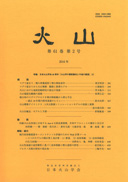巻号一覧

37 巻, 5 号
選択された号の論文の6件中1~6を表示しています
- |<
- <
- 1
- >
- >|
-
原稿種別: 口絵写真
1992 年 37 巻 5 号 p. App2-
発行日: 1992/11/15
公開日: 2017/03/20
ジャーナル フリーPDF形式でダウンロード (20042K) -
高田 亮, 大島 治, 荒牧 重雄, 小野 晃司, 吉田 克史, 梶間 和彦原稿種別: 論説
1992 年 37 巻 5 号 p. 233-250
発行日: 1992/11/15
公開日: 2017/03/20
ジャーナル フリーThe subaerial history of Aogashima volcano (about 3 km3 in volume) was studied. The sequence of volcanic activity is summarized as follows: the growth of Kurosaki volcano (0.3 km3 in volume; basalt>andesite) in the northwestern area of Aogashima island; the construction of the main edifice of Main stratocone (basalt≫andesite) in the southeastern area; the fissure eruptions of Aphyric basalts (<0.1km3 in volume) on the northwestern flank; a surge activity (Ojiroike surge deposits) (basalt>ndesite) at about 3,000 y.B.P.; the eruptions of Kintagaura lavas (0.15 km3 in volume) filing the Southeasern basin, and airfalls (Yasundogo airfalls tephras) (0.4 km3 in volume; basalt>andesite) on the east and north flanks 3,000-2,400 y.B.P.; the occurrence of a debris avalanche (Nagashizaka debris avalanche deposits) associated with the formation of the Ikenosawa crater (1.7 km×1.5 km insize); the Tenmei (A.D. 1781-1785) eruption (0.08km3 in volume; andesite). Based on the historical records and the geological data obtained in this study, the sequence of the Tenmei eruption is restored as follows: according to historical records, a small ash eruption occurred in 1781; in 1783, the Tenmei eruption began with an explosive scoria effusion (Tenmei airfall tephras 1) associated with cone building (Maruyama pyroclastic cone); in 1785, ash fall continued intermittently for more than one month (Tenmei airfall tephras 2); finally, the Ikenosawa crater was filled with lava flows (Tenmei lavas 1 and 2). During the development of Aogashima volcano, magma paths were shifted over a distance of about 4 km. Some geological units derived from different magma paths have different, parallel trends of chemical composition in SiO2 vs. oxide diagrams. The chemical composition of magma changed with the shift in magma path. Each trend consists of a combination of plagioclase accumulation and crystallization. The magma-supply rate of Aogashima volcano was fluctuating in time and space with the growth of each geological unit, which may have led to the generation of andesite magma.抄録全体を表示PDF形式でダウンロード (9859K) -
鈴木 毅彦原稿種別: 論説
1992 年 37 巻 5 号 p. 251-263
発行日: 1992/11/15
公開日: 2017/03/20
ジャーナル フリーNasu Volcano is a polygenetic volcano locating on the volcanic front of Northeast Japan Arc. The eruptive history of this volcano during the last 350,000 years is clarified by tephrochronology. On the eastern foot of this volcano, 16 pyroclastic fall deposits are identified. The stratigraphic relations of these deposits with well dated tephra layers derived from other volcanoes provided the chronological framework for the eruptive history. Moreover, the estimated ages and volumes of each deposits, determined by an empirical formula, gave eruption rate of pyroclastic fall deposits. Nasu-Shirakawa Tephra Group (Sr1 to Sr12) erupted from 350 ka to 200 ka. The frequency of explosive eruption during this period is 0.08 times per 1000 years, and eruption rate of pyroclastic fall deposits in dense rock equivalent volume is 0.016 km3 per 1000 years. On the other hand, a K-Ar dating chronology for Nasu Volcano carried out by a previous study shows that no effusions of lava flows occurred during this period. After this period, no obvious explosive eruptions occurred until 55 ka. This non explosive period is most likely corresponds to the stage characlerized by effusions of lava flows which was recognized by the K-Ar dating chronology. The eruption rate of this period is larger than that of former period from 350 ka to 200 ka. The younger stage from 55-50 ka to present is not characterized only by explosive eruptions (occurrences of Kuromori Tephra and Oshima Tephra 1 and 4; Kr, Os 1 and 4) but also by effusions of lava flows, occurrences of pyroclastic flows, formations of lava dome and pyroclastic cone. The frequency of explosive eruption and the eruption rate of pyroclastic fall deposits during this period are 0.06 times per 1000 years and <0.003 km3 per 1000 years, respectively. Both are smaller than those of the period from 350 ka to 200 ka.抄録全体を表示PDF形式でダウンロード (1234K) -
川上 紳一, 金折 裕司, 荒川 崇史, 中村 俊夫原稿種別: 寄書
1992 年 37 巻 5 号 p. 265-268
発行日: 1992/11/15
公開日: 2017/03/20
ジャーナル フリーPDF形式でダウンロード (437K) -
二ノ宮 淳, 荒井 章司原稿種別: 寄書
1992 年 37 巻 5 号 p. 269-273
発行日: 1992/11/15
公開日: 2017/03/20
ジャーナル フリーPDF形式でダウンロード (11441K) -
井村 隆介原稿種別: 口絵写真解説
1992 年 37 巻 5 号 p. 281-283
発行日: 1992/11/15
公開日: 2017/03/20
ジャーナル フリーPDF形式でダウンロード (387K)
- |<
- <
- 1
- >
- >|